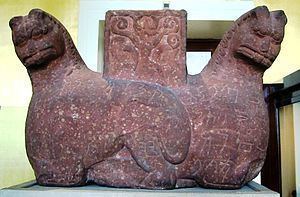Created 1-10 CE | ||
 | ||
Size 16.75 inches tip to tip Similar Farnese Diadumenos, Kayung totem pole, Bassae Frieze, Jennings Dog, Sphinx of Taharqo | ||
The Mathura lion capital is an Indo-Scythian sandstone capital from Mathura in Central India, dated to the first decade of the 1st century CE (1-10 CE). It was consecrated under the rule of Rajuvula, one of the Northern Satraps of the region of Mathura.
Contents
The capital was excavated by Bhagwan Lal Indraji in 1869. It is covered with Prakrit inscriptions in the kharoshthi script of northwestern India. The capital was made on the occasion of the funeral of "the illustrious king Muki and his horse" (Muki has been conjectured to be Maues).
The capital describes, among other donations, the gift of a stupa with a relic of the Buddha, by Queen Ayasia, the "chief queen of the Indo-Scythian ruler of Mathura, satrap Rajuvula". She is mentioned as the "daughter of Kharahostes" (See: Mathura Lion Capital inscriptions below). The lion capital also mentions the genealogy of several Indo-Scythian satraps of Mathura. It mentions Sodasa, son of Rajuvula, who succeeded him and also made Mathura his capital.
The capital also displays at its center a Buddhist triratana symbol, further confirming the involvement of Indo-Scythian rulers with Buddhism.
The inscription indicates support of the Sarvastivadin, against the Mahasamghikas.
It is on display at the British Museum in the Joseph E. Hotung Gallery.
List of inscriptions
Here is the list of the inscriptions in simplified Gandhari script:
Interpretation
Sten Konow, who compiled a definitive listing of Indian Buddhist inscriptions said: "If we bear in mind that mb becomes m i.e mm in the dialect of Kharoshthi dhammapada, and that is used for the common o in Sudasa in the Lion Capital Inscriptions, the Kamuia of the Lion Capital can very well represent a Sanskrit Kambojika ... I shall only add that if Kharoshtha and his father Arta were Kambojas, the same may have been the case with Moga, and we understand why the Kambojas are sometimes mentioned with the Sakas and Yavanas". Many of Konow's readings, his sequence of sentences and some of the interpretation, particularly the connection with king Maues, need to be changed in the light of a new reading of H. Falk.
